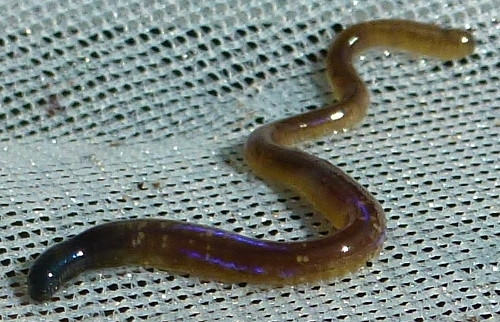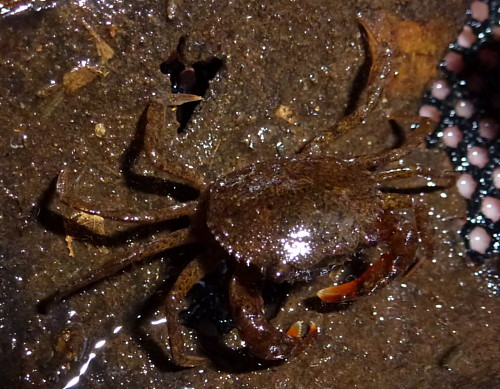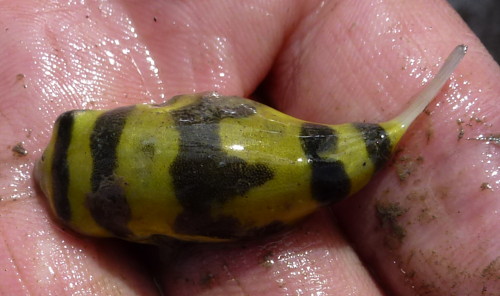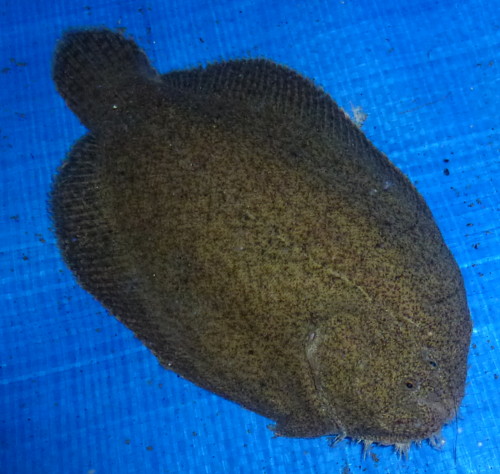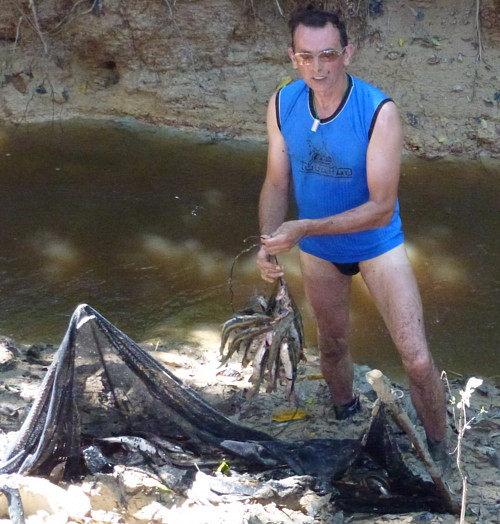|
Trying to distill everything that happened over
5 weeks of collecting & sorting out over 900 photos would make a
long article so I just put here a flavour of the trip.
I wanted to go to Colombia for a few years but always something got
in the way which was usually money or scared of plunging into a totally
different culture not knowing what to expect or how to deal with it.
Steve McAlear was going over to his lodge in the rainforest in June
& I was determined to go not really expecting what the trip involved.
This was to be a commercial fish collecting trip to fill a jungle fish
house with fish for export. My killie collecting was something to do
as & when time permitted. This piece is biased to collecting Rivulus.
It would be outside the space available here to put photos on of all
the fish we collected.
We travelled from Birmingham to Frankfurt, changing for a direct flight
to Bogota, Colombia where we overnighted at a local hotel. Bogota is
supposed to be one of the most dangerous cities in the world but I didn't
see any problems in the short time we were there. In the morning it
was a return to the Airport & an internal 2 hour flight on LAN to
Leticia our final destination. I had to pay the equivilant of £8
tourist tax on arrival. Just something you have to pay to get out of
the airport.
Steve's rainforest lodge is called Albergue Tacana & is set about
15 kms outside the airport & main town. Most tourists stay in the
main air conditioned hotel in town & 'do Amazonia'. The lodge is
part of a Bora Indian community & locals pop in all the time.
If you really want to taste life in the rainforest you should really
try a holiday at Steve's place. You can collect your own fish &
they can arrange a legitimate freight transfer of your fish box/es.
We spent about 4 weeks going from one official to another & paying
out here & there to get the export licence so you can get your fish
home. You may of course need to check your countries import regulations
regarding your own imports.
First morning we were out fishing in a Rio Tacana tributary not far
from the lodge. We were collecting commercial fish such as hatchets,
pencils etc. We collected Farlowella,
a few Corydoras & a catfish
not seen here before Physopyxis lyra
Cope 1871. This one was a cause for some excitement but we only collected
around 10 fish during our stay including some young. All were collected
in the same spot near a sunken branch.
We caught no Rivulus at this location
but went downstream along a particularly difficult stream walk through
sunken wood & branches & collected a few Rivulus
with little colour. Coral snakes have been seen previously around the
village & wood is where they can hide so for a first trip doing
this sort of thing I was a little nervous. Coral snakes are back fanged
so have to get a good grip on you to be a problem. My motto is to give
every snake respect & a wide berth.
We have had imports from this location before which were called Tacana
drainage which is a fair description.
The usual way a day went was to be up about an hour before dawn &
get on the bike as the sun was coming up. It's fatal to collect later
as it gets hotter & the fish die. Collecting on the Amazon main
river especially longer distances can be really difficult in water changing
& aeration keeping fish alive to get back to the fish house. Sometimes
you collect in shallow areas where the water is literally hot &
you cannot change water until you get to deeper water.
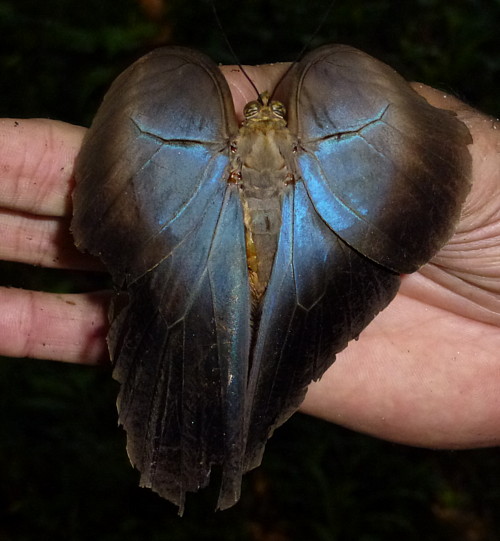 |
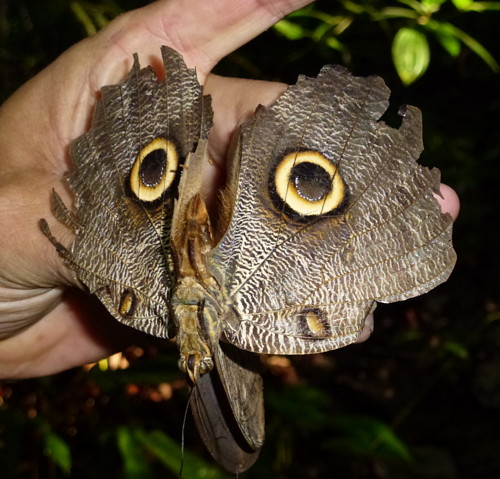 Owl Moth seen on a trail. The photo on
the left is what you see from the top. The photo on the left
is the underside. You can see why they call it an Owl Moth.
Owl Moth seen on a trail. The photo on
the left is what you see from the top. The photo on the left
is the underside. You can see why they call it an Owl Moth. |
The area surrounding the village of Tacana was
used to cultivate Coca which is made into cocaine. When I was there
all these areas had gone & the dams they built to hold water had
been destroyed leaving in some cases nice pools to fish.
To explain the bike thing - most travel in Leticia is done on bikes.
A trail bike in fish collecting is a bonus. You sit on the back with
collecting bins, nets & have to go through rough terrain in some
cases to get to a biotope.
The day before we came back one of the local Indians killed a 20' Anaconda
near an area we used for fishing. Can you believe he strangled it with
a rope before someone cut it's head off. Anaconda are feared in the
local communities as they have been known to take children while bathing
near the river.
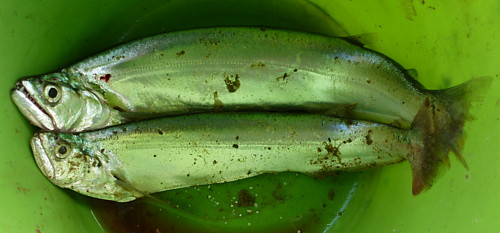
I caught these 2 on rod & line. Big teeth but good to eat
so they went into the pot. They were fishing themselves at the
time with fish jumping out of the water to get away from them.
Pink Dolphins were also in the area fishing. Probably these
fish were getting in on the act.
In this area large stingrays were caught previously. |
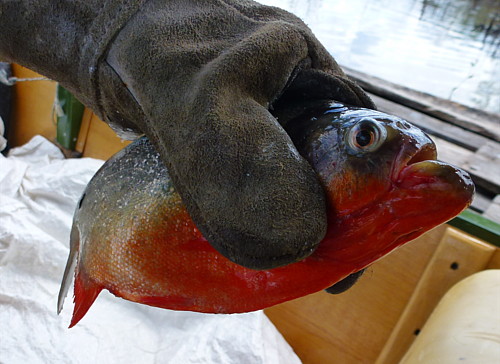
Piranha caught by Fred who is taking no chances of getting bit. |
Bogota
We flew from Birmingham to Frankfurt & changed planes for Bogota.
We had to stay overnight in an hotel before getting an internal flight
to Leticia. The photo shows the padlocked gate entrance to the hotel.
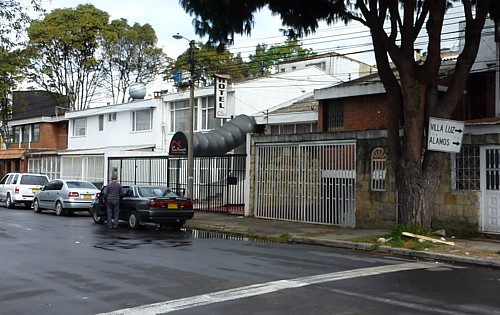
The
Fish House
When fish were caught they were put into the quarantine
shed before entering the main fish house.
During the stay I helped Pedro, a local Indian reroof the fish house
with leaves. These were made up into panels by the local Indians &
fixed to poles on the roof. In the full sun this was extremely sweaty
work.
The photo below shows a fire burning off the old roof & leaves around
the fish house. I think Indians get a bad press about deforestation.
This is mainly done by big companies. Native people clear small areas
around a house or village to make a safe area where they can see snakes.
The fire produces smoke which clears the area of mosquito's. It does
work.
It was not a normal fish house to work in as it was wise to check the
place over for snakes & various spiders which could put you on your
back if bitten. Basically always look where your fingers are. Ants are
all around. The big ones are almost 1" but are harmless. The ones
to avoid are the tiny ones which can give a mean bite.
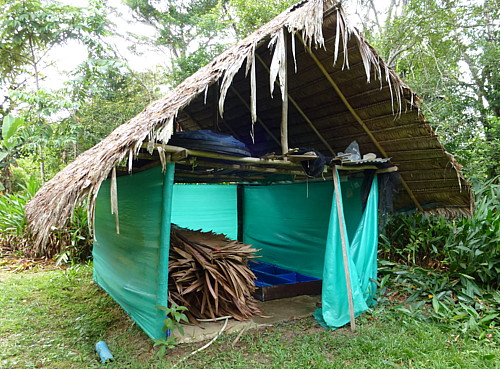 Quarantine Shed
Quarantine Shed |
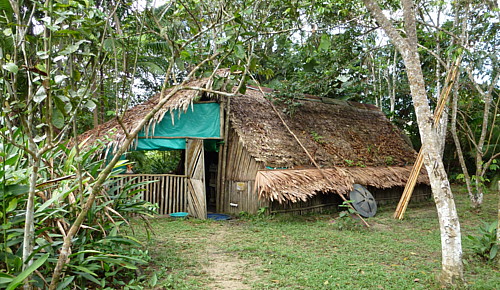 The fish house. Home to our collections
over the collecting period.
The fish house. Home to our collections
over the collecting period. |
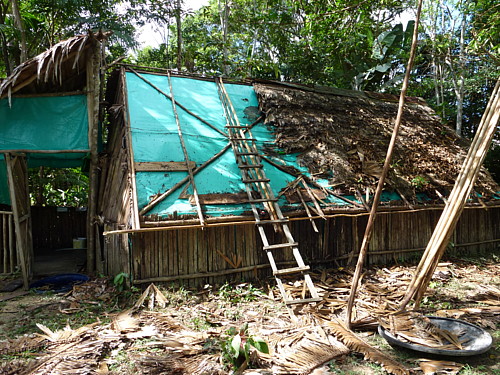 Fish house roof being stripped off.
Fish house roof being stripped off. |
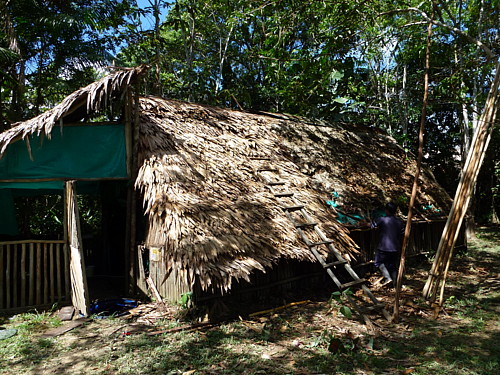 New leaves added.
New leaves added. |
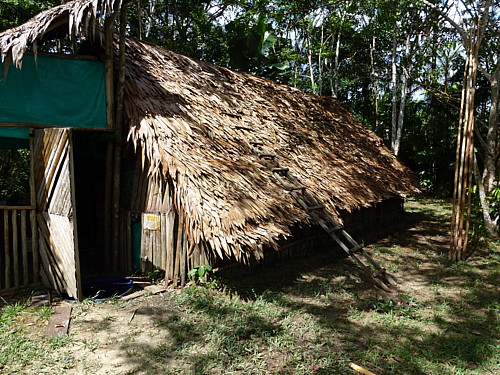 Finished reroofed side.
Finished reroofed side. |
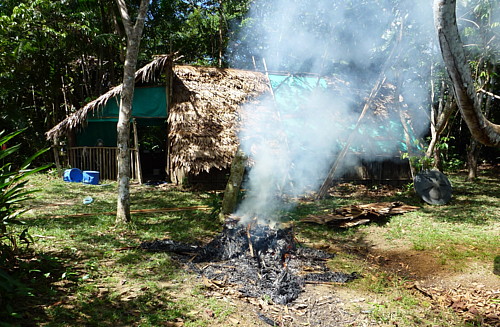 Burning the old roof.
Burning the old roof. |
The following locations are just those where we
collected Rivulus. Please note the
genus has changed to Anablepsoides.
We collected from a lot of biotopes for commercial shipping & it's
not possible to list them all here.
Location
1 - AM 2012/1
Situated in the Tacana village.
Fairly shallow biotope up to chest height with some scrambling over
fallen trees. The drag net was pulled over the sandy bottom which had
leaves & debris. The scoop net was used under the overhanging grasses.
The Rivulus were collected some
distance downstream. It was difficult to walk down the stream as it
had a lot of tangled wood on the stream bottom. We only collected a
few fish but all were taken by some animal in the fish house. We lost
a few fish in this way until we went out & bought some sealed containers.
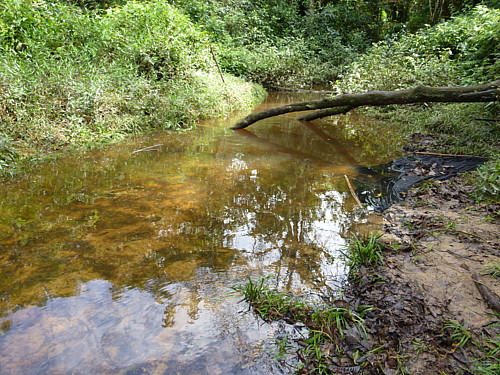 |
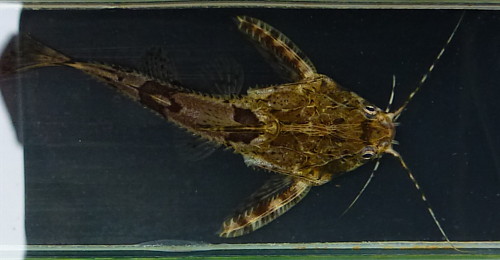
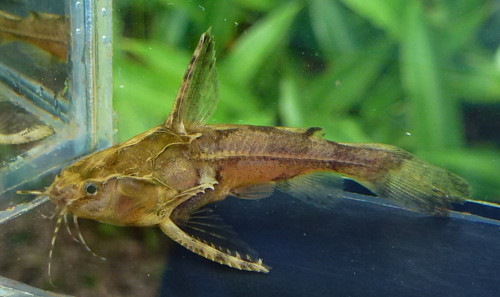
This is Physopyxis
lyra Cope 1871. Not collected in this location before.
It was only found in the little bay top left of the photo to the
left. We only colected about 10 fish & 2 young. A small fish
about 3 cm.
We caught Pencils, Hatchets & a load of other fish at this
location. |
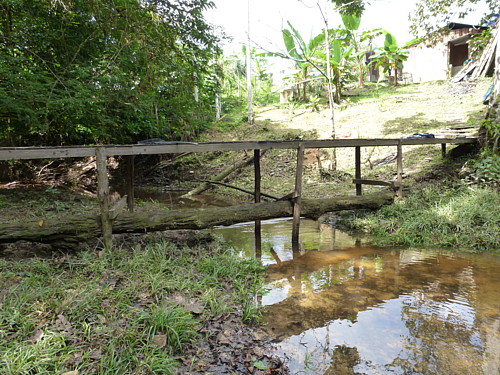 The bridge
The bridge |
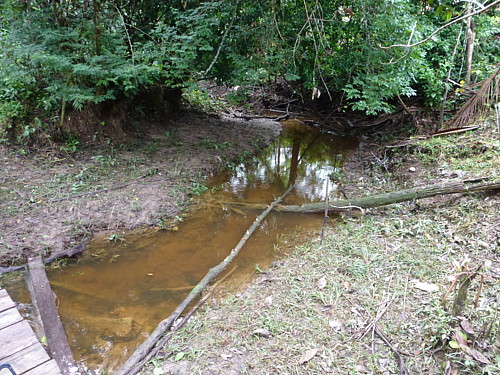
Downstream from the bridge |
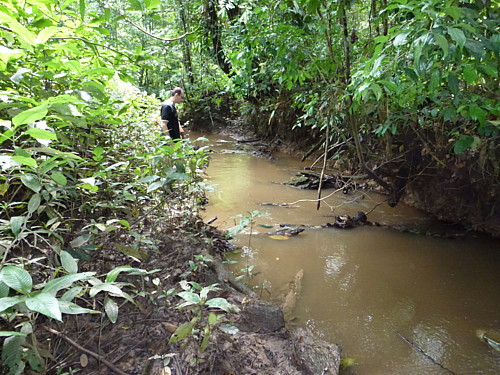 A little further downstream from the bridge
where it became difficult to fish.
A little further downstream from the bridge
where it became difficult to fish. |
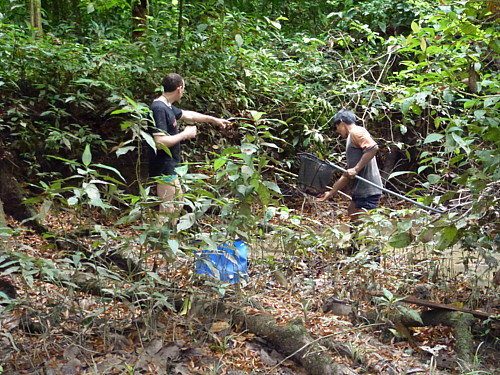
Steve & Pedro collecting a few Rivulus
in a side boggy area. |
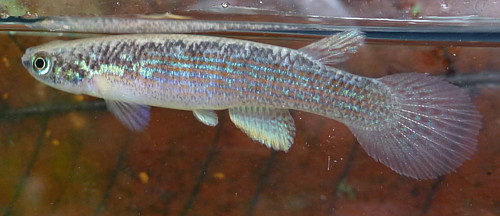 Male Rivulus
rubrolineatus from location 1.
Male Rivulus
rubrolineatus from location 1. |

Female Rivulus
rubrolineatus from location 1. |
Location
2 - AM 2012/2
Stream draining into the Tacana River,
Tacana. Wide stream with a fair flow. Lots of sunken wood so we caught
Farlowella & a Tatia.
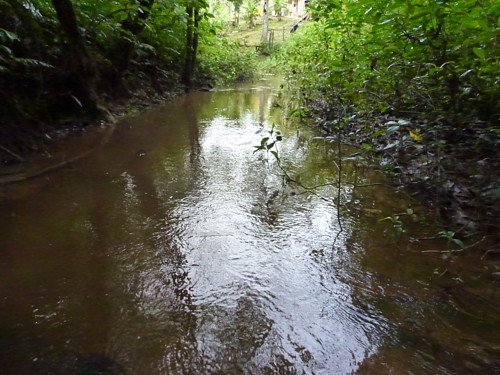 |
|
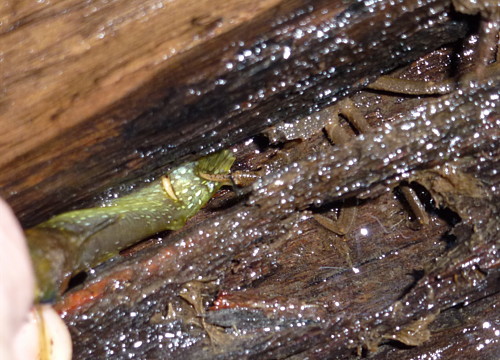 Collecting a Tatia
sp. from a wood crevice. Note the crab pulling the other end.
Collecting a Tatia
sp. from a wood crevice. Note the crab pulling the other end. |
|
Location
3 - Tanimboca Reserve - AM 2012/3
The reserve is situated at km 11 near
Tacana. It is currently expanding the number of accomodation buildings.
It's a great place to explore along the trails with many places to fish.
We had permission from the manager - Goran to fish the reserve &
we would like to thank him for this.
You
can see more on the reserve here including booking information.
We visited Goran late one afternoon.
This involved about half a mile trek along a trail to his house in the
jungle. On returning the sun had gone down & we had to get back
in pitch blackness helped with a mobile phone. It's a really scary thing
to do but the jungle does come alive at night & people pay for these
night walks. I'm glad I did it but at the time I wanted Scotty to beam
me up..
|
|
|
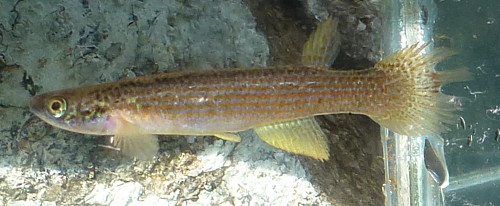 Male Riv.rubrolineatus
from location 3.
Male Riv.rubrolineatus
from location 3. |
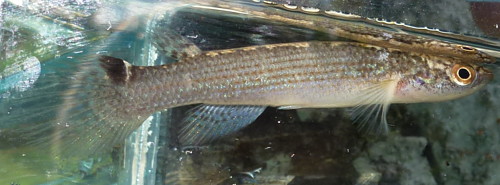
Female Riv.rubrolineatus
from location 3. |
Location
4 - AM 2012/4
Tributary of the Tacana River.
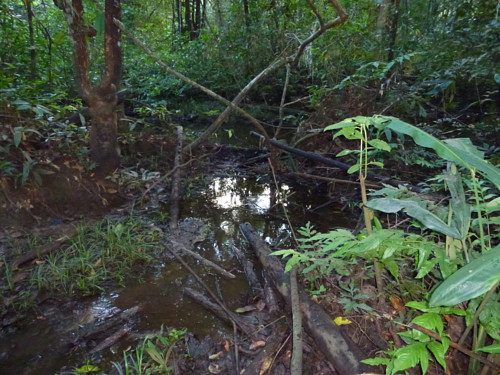 |
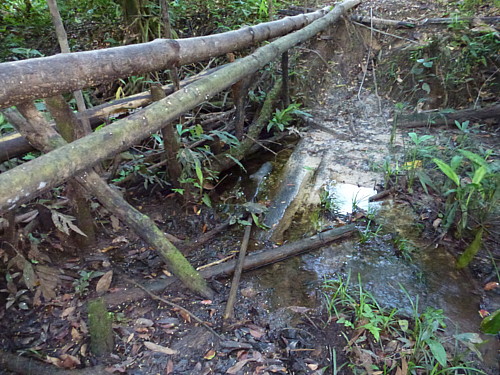 |
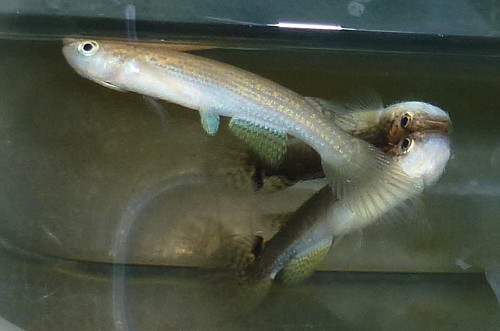 Rivulus
collected at location 4 (possibly Riv.rubrolineatus).
Rivulus
collected at location 4 (possibly Riv.rubrolineatus). |
|
Location
5 - ('Fred's Stream') just outside Leticia. AM 2015/5
Deepish stream becoming shallow. We
caught Rivulus about where Steve
is fishing & also in a drying out pool just outside the main stream.
Not a great many fish collected but the Rivulus
were worth collecting. The females disappeared in the fish house despite
a tight fitting lid which was a bit of a mystery. We didn't bring the
males back. Definately worth recollecting. Hopefully the lads over there
will try again & ship some over.
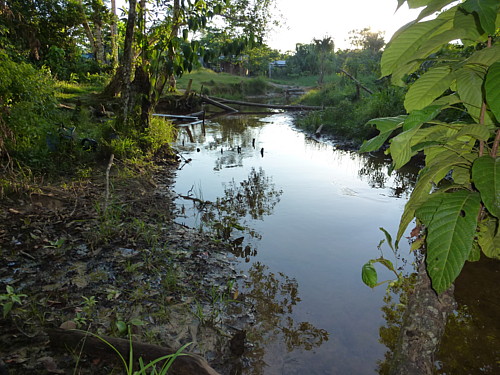 |
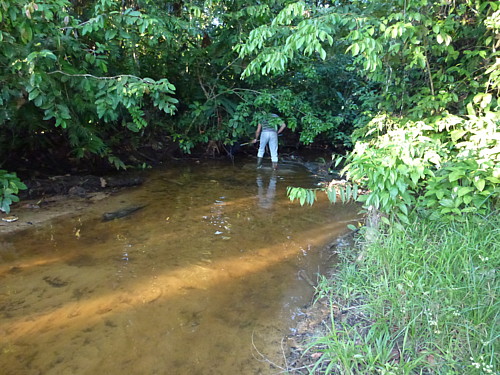 |
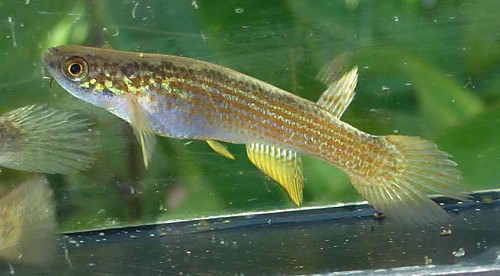 Male Rivulus
rubrolineatus collected at location 5.
Male Rivulus
rubrolineatus collected at location 5. |
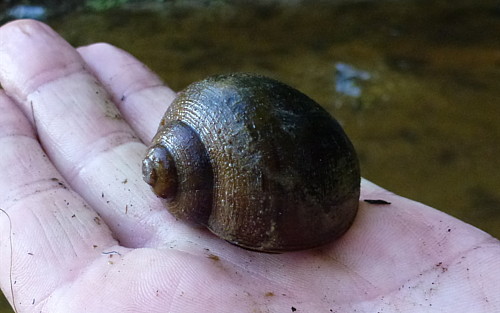 Snail
Snail |
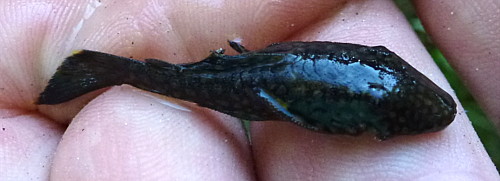 Ancistrus
form
Ancistrus
form |
|
Location
6 - AM 2012/6
Quistacocha Zoo, Iquitos. We had no
net so we had to improvise. A visit to a friend known as Mad Mick was
useful & we looted a fan cover. Taking out the centre we had some
netting given to us & Steve did a great job sewing it onto the frame.
It worked remarkably well & we caught quite a few Rivulus
& a Hoplosternum juevenile in
the lake side.
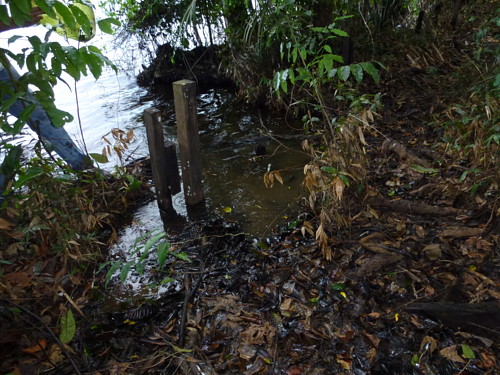 Collecting spot for the Rivulus
we caught.
Collecting spot for the Rivulus
we caught. |
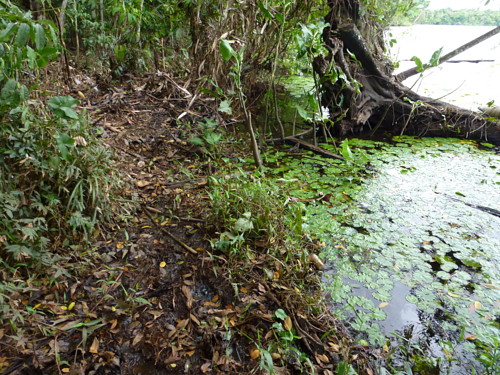 Water Lilies which flower white were likely
spots to fish but we couldn't find Rivulus
under the pads.
Water Lilies which flower white were likely
spots to fish but we couldn't find Rivulus
under the pads. |
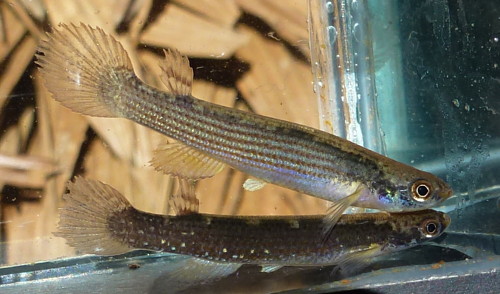 Rivulus
collected here. Top fish is Riv.rubrolineatus.
The bottom one was dark brown with bright spots. Possibly another
rubrolineatus but different.
Rivulus
collected here. Top fish is Riv.rubrolineatus.
The bottom one was dark brown with bright spots. Possibly another
rubrolineatus but different.
We had hoped to find Riv.speciosus
but time was against us. Also we were not fully equipped to
go further around the lake to fish. A machette was something
we badly needed along with wading gear. |
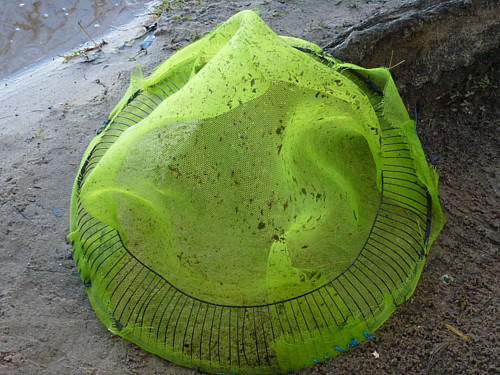 The heath robinson net we made up on the
day. Don't laugh - it worked well.
The heath robinson net we made up on the
day. Don't laugh - it worked well. |
Location
7 - AM 2012/7
One of the quests for the trip was
to relocate Alan's Red Rivulus.
We did this after about a mile of tramping through mud & crossing
a stick bridge as well as jumping a fast flowing strem. Eventually we
found a boggy area with little water & a trickle of water passing
through it. We went to the location 2 times. The first we found only
5 fish which were very small. The 2nd time we were determined to make
a decent collection & spent about 2 hours in fairly deep mud at
times. We adopted a different approach to finding them by walking through
an area to muddy the water up then just standing still over it. Before
long young Rivulus came to the surface
& were collected. These were very small, in many cases less than
1 cm but we did collect enough to take back & grow on in the UK.
We still have no idea what the fish are. They are too small to be the
usually found Riv.rubrolineatus.
Hopefully as they grow I can update the page with photos.
The Red Rivulus is now named Laimosemion
leticia.
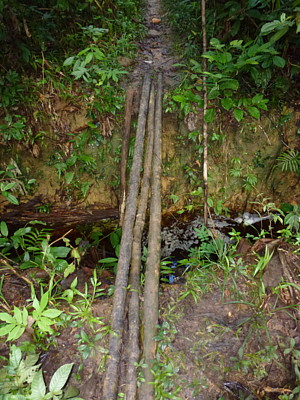 The first obstacle. A stick bridge over
a 2 metre gorge across the trail.
The first obstacle. A stick bridge over
a 2 metre gorge across the trail. |
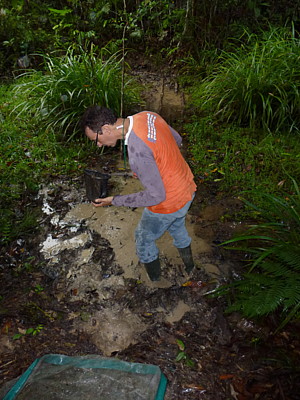 Steve searching for the elusive Rivulus.
Steve searching for the elusive Rivulus. |
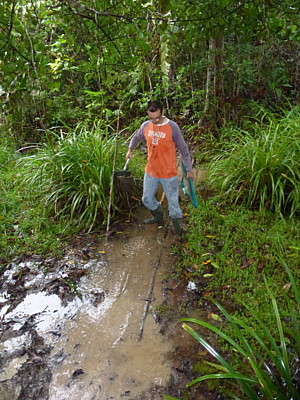 A stick walkway across the bog. One slip
& it was two feet of mud.
A stick walkway across the bog. One slip
& it was two feet of mud. |
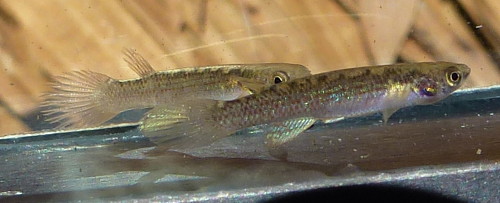 Young Rivulus
from Location 7. These were the largest collected & of the
Riv.rubrolineatus form.
Young Rivulus
from Location 7. These were the largest collected & of the
Riv.rubrolineatus form.
|
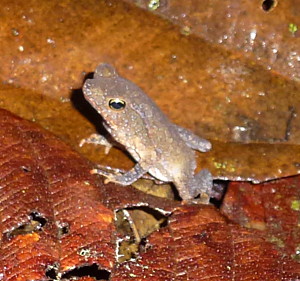 Small tree frog near the biotope which
had a lot of tadpoles. This area is home to some of the most
poisonous frogs on the continent.
Small tree frog near the biotope which
had a lot of tadpoles. This area is home to some of the most
poisonous frogs on the continent. |
 Riv rubrolineatus
form. We only collected 2 males. As all the fish were very
Riv rubrolineatus
form. We only collected 2 males. As all the fish were very
small it was not possible to know how they would turn out. |
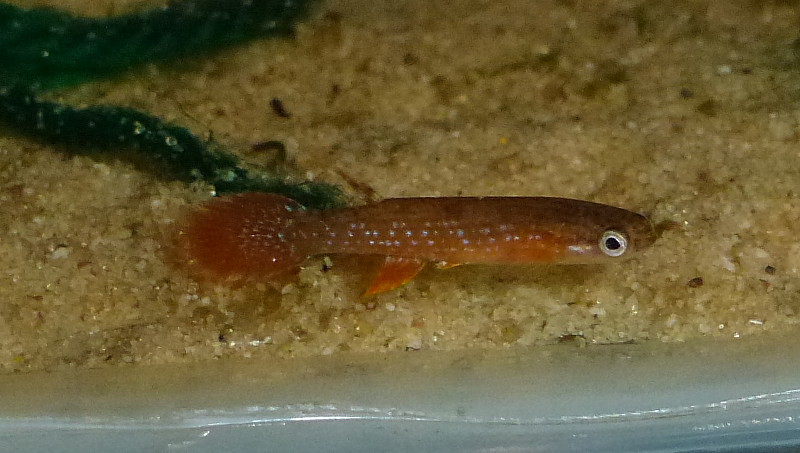 The Red Rivulus,
Laimosemion leticia. Totally
different shape to the fish on the left & they so far have
stayed small, being sexually mature at 15mm.
The Red Rivulus,
Laimosemion leticia. Totally
different shape to the fish on the left & they so far have
stayed small, being sexually mature at 15mm. |
Location
8 - AM 2012/8
Another trek through the jungle that
started by crossing the Tacana River over a fallen tree (photo on right
below). This was a bit scary carrying nets & collecting bin. Also,
wet muddy wellies are not the best to try it.
This was a dark location & the fish were darker. We caught quite
a few knife fish at this location.
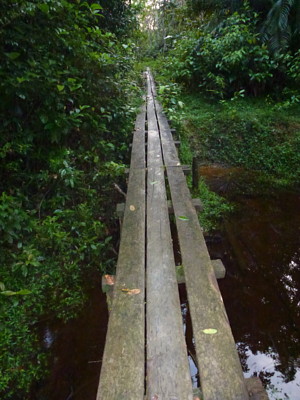 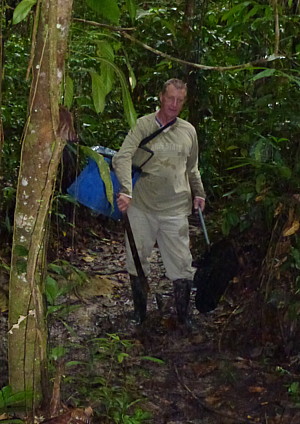 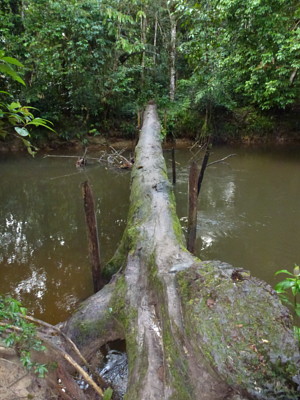
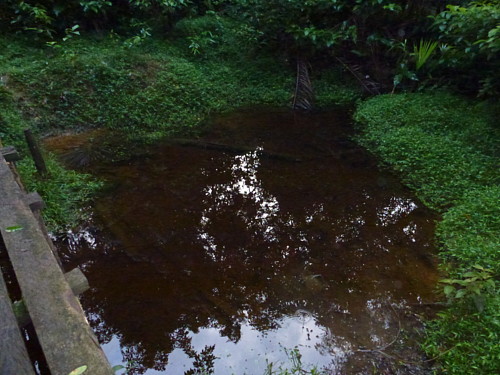
On the right of the bridge a wide pool.
Typically pencils, hatchets, Apistogramma
were found as well as quite a lot of knife fish, some very dark
Crenuchus spilurus. No Rivulus
this side of the bridge. |
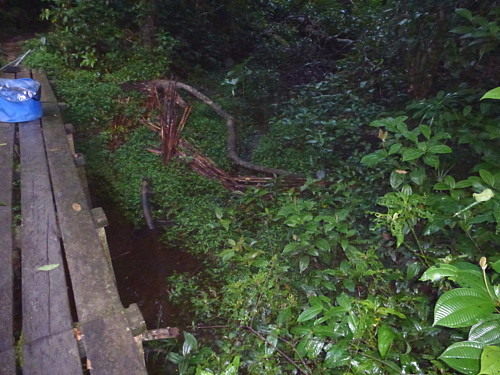
On the left of the bridge (upstream) we
found Rivulus in small numbers
but quite large fish. This was an area of dense foliage. Also
collected a crab here. |
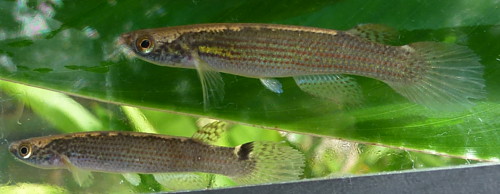 Rivulus rubrolineatus
collected at location 8.
Rivulus rubrolineatus
collected at location 8. |
 Knife Fish collected at this location.
Knife Fish collected at this location. |
Location
9 - AM 2012/9
Stream flowing under the road past
km 11. We caught all the Rivulus
in a narrow, shallow stream with a gentle flow. No other fish collected.
These were the most colourful population of Riv.rubrolineatus
we caught.
The photo below was taken on the road looking into the forest. The water
in the foreground was too deep for Rivulus
& they were all collected in the plants going into the dark area.
This was a slow flowing stream only a couple of inches deep.
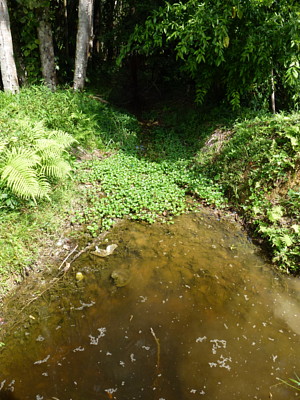
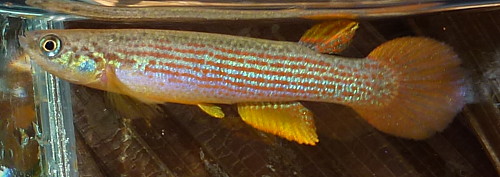 Male Riv.rubrolineatus
from location 9
Male Riv.rubrolineatus
from location 9 |
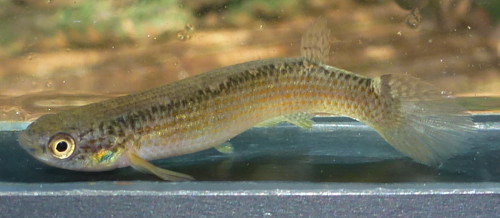 Female Riv.rubrolineatus
from location 9
Female Riv.rubrolineatus
from location 9 |
|
|
|
Iquitos
Iquitos is a Peruvian town situated some 900 kms upstream from Leticia
& is home to various fish exporters who buy in fish from local collectors.
It's an exciting place to visit but involves an early start & a
fast boat called a Rapido.
We had to walk from Leticia in the early hours to Tabatinga which is
basically the Brazilian part of Leticia. The Rapido departed from Santa
Rosa which was on the other side of the Amazon River. Colombian taxi
boats didn't run at this time of the night. The walk through the back
streets of Tabatinga was a little scary especially as Steve mentioned
it was one of the most dangerous roads in Brazil with 17 murders to
it's name.
On arrival we had to wait on a Balsa which is a house or shop built
on logs & floats. The Rapido was loaded to capacity which meant
it would be slower. Ususlly it takes 9 - 10 hours to get to Iquitos
but in this case it took over 13 which made it a long journey.
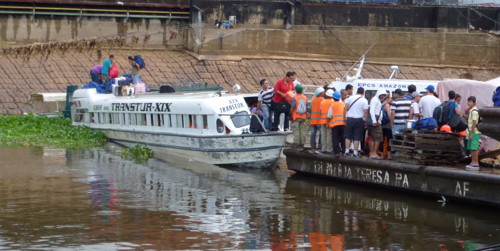
The Rapido we took to Iquitos after being hit by a barge. |
On
arrival in Iquitos the crew had to report to the Captain of the
Harbour (Harbourmaster). This meant docking in the commercial
area. On backing out a huge barge drifted towards us closing the
only gap to get out. It started to look dangerous & the Rapido
was hit by the barge in the stern. The Rapido changed direction
to get away from the barge but was badly damaged & holed although
we didn't realise the extent of the damage at the time. The crew
tried to find another way out but hit another boat. On this the
crew all abandoned ship leaving all the passengers. We sat &
watched as the boat drifted into the middle of the harbour listing
from the stern. It was time to get off & one of the passengers
tried to use a length of wood to push us to shore. Eventually
some dock workers threw us a line & pulled us to another barge
where we jumped off.
After this it was a walk through the docks to the road & a
taxi bike ride to the hotel. |
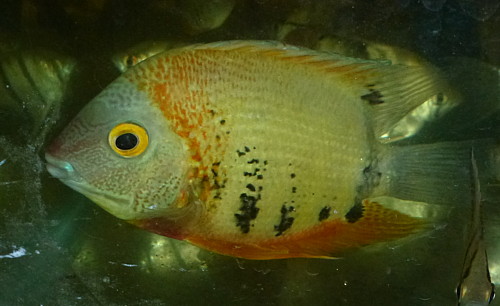 Wild caught severus
Wild caught severus
|
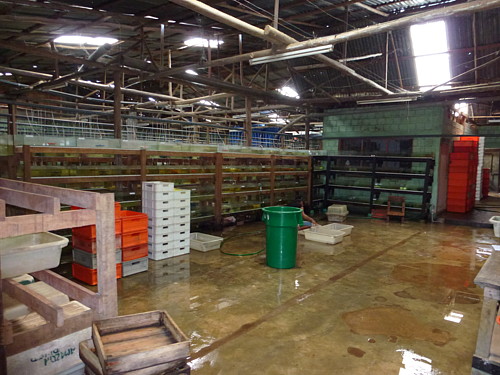 Fish shipper in Iquitos.
Fish shipper in Iquitos. |
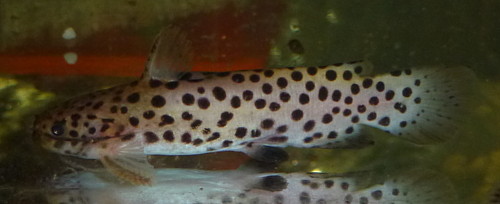 We had not seen this catfish before.
We had not seen this catfish before.

'L' type catfish. |
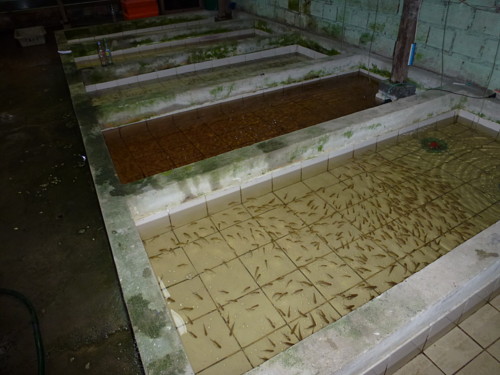 Holding ponds in the facility.
Holding ponds in the facility. |
|

